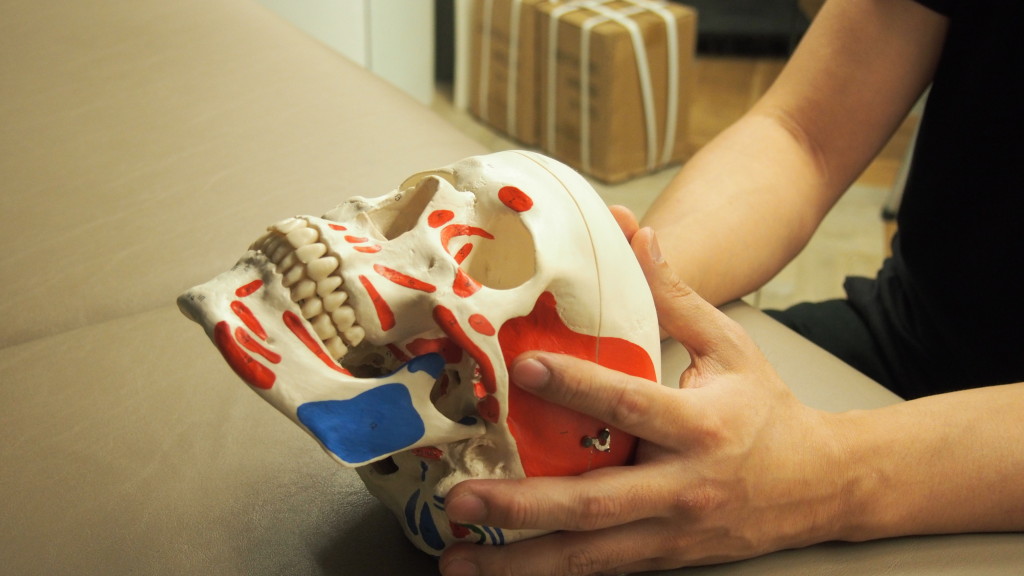
History of Craniosacral Therapy
Craniosacral therapy has its origins in osteopathy. When Dr William Sutherland (1873 – 1954) studied the separate bones of the skull he postulated that those bones had the appearance of structures made for movement. At the time, medical convention understood the adult human skull to be completely fused. Reluctant to believe the cranium bones were fused, he started to palpate with his hands and discovered an intrinsic movement occurring within the cranium. He then set about designing an experiment to test whether the skull was in motion. He devised a special helmet with screws to tighten the helmet over specific bones of the skull so as to prevent even the slightest movement. His first experiment was on himself. He and his wife wrote down their observations of his physical and mental symptoms and behavior.
From this work, Sutherland developed what is now known as cranial osteopathy. He was the first person to recognise the movement of the cranial bones and the expansion and contraction that occurs in the cerebrospinal fluid within the skull.
In the 1970s, Dr. John Upledger, DO, OMM, a medical doctor by training, discovered the cranial rhythm for the first time himself, while he was assisting in a surgical operation, in which he had to hold still the thick membrane surrounding the spinal cord, called the dura mater. During this procedure, Dr Upledger found great difficulty preventing its motion, and discovered that it moved in a rhythm of 8-10 cycles per minute. This original experience led him to continuingly search for the cause. In 1975, as a professor of biomechanics, Dr Upledger joined Michigan State of University, where he led a research team of biophysicists, anatomists and other professionals to perfect the scientific basis for the craniosacral system, and to advance contemporary knowledge of how to alleviate chronic pain and dysfunction.
The Therapy
During therapy, osseous bony and membranous restrictions are distinctly palpable. Any constriction or resistance within the body structure can disturb the cranial bone motion and thereby be picked up. Therapy helps the body to re-establish the original movement flow of cerebrospinal fluid by assisting in the resolution of any resistance patterns.
A craniosacral therapist besides working on the craniosacral system works also on the fascia in the body which can be described as a body stocking under the skin holding us together. All body parts are interconnected by the fascia explaining why bizarre symptoms are experienced in some parts of the body when a seemingly unrelated part of the body is being worked upon.
The pressure used in craniosacral therapy is very gentle, subtle and sometimes barely perceptible. It may seem amazing how such light touch could effect any change so deep as to assist in removing impediments to the flow of cerebrospinal fluid which have been created within the cranium and spinal cord. The craniosacral system of the client is worked on by the therapist in a non-obtrusive “melding” fashion with him/her, especially beneficial for the sensitive client whose body’s response is guarded whenever firm pressure is applied. The touch of a craniosacral therapist is reassuring to those in acute pain and distress as it does not feel invasive.
Persons who may benefit from craniosacral therapy:
- Seizure Disorders
- Autism Spectrum Disorders
- Cerebral Palsy and Spasticity
- Learning Disabilities
- Hyperkinesia (hyperactivity)
- Attention Deficit Disorder
- Dyslexia and Dyscalculia
- Developmental Delay
- Motor-Coordination Impairments
- Emotional Difficulties
- Stress and Tension-Related Problems
- Post-Traumatic Stress Disorder
- Migraine Headaches
- Tinnitus
- Temporomandibular Joint Syndrome (TMJ)
- Chronic Pain Syndromes
- Arthritis and Joint Pain
- Neuralgia
- Fibromyalgia and other Connective-Tissue Disorders
- Low Back Problems and Backache
- Reflex Sympathetic Dystrophy (RSD)
- Traumatic Injuries including Brain and Spinal Cord Injuries
- Central Nervous System Disorders
- Stroke and Post Operative Rehabilitation
- Assisting in Cases of Difficult Labor
Tissue releases are said to have occurred when these phenomena occur: heat, pulsation, twitching, borborygma (tummy gurgling). The client is in a deep state of relaxation and may experience one or all of the signs of release. At the structural level, the therapist aims to correct restrictions deep within the body but there are times when, the body during a session, finds it appropriate to release stored-up emotion. There may be crying, laughing or shaking. This is called somato-emotional release, a process the client engages in when their non-conscious mind is ready. Remember this is not possible should there be conscious resistance on the part of the client.
The application of this therapy is wide and because of its non-invasive nature, is particularly suited to young infants and the elderly where other therapies may be adjudged to be too vigorous.
For more information on the conditions treated by craniosacral therapists, click on the website of the Upledger Institute Inc. www.iahe.com
Craniosacral techniques are used in conjunction with spinal manipulative therapy by our chiropractor, or with structural integration techniques by the Advanced Rolf Practitioner where appropriate depending on the clinical situation.